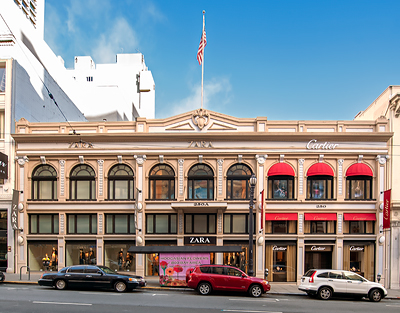San Francisco Points of Interest
250 Post Street
Built 1908
Gump's, a luxury home furnishings retailer, was located here from 1906 until 1995. Gump's slogan was "where good taste costs no more."
The founder, Solomon Gump, was born in Heidelberg in 1833. In 1850, he immigrated to the United Sates, and after ten years in Florida, he moved to San Francisco.
In 1861, Solomon and his brother-in-law, David Hausmann, opened David Hausmann & Co., a shop which specialized in gold picture frames and mirrors. In 1864, Solomon became sole owner of the shop. In 1871, Gustave Gump joined his brother Solomon in the family store, which they renamed S & G Gump: Mirrors, Mouldings, and Paintings.
The brothers started the first art gallery in San Francisco, importing paintings from Europe to fill their gilded frames. During the 1880s, Solomon and Gustave traveled between Europe and San Francisco to purchase art and antiques for their store, now located at 535 Clay Street and now renamed, simply, Gump's.
Gump's expanded and moved several times. It was located on Geary Street when it was destroyed by the 1906 Earthquake and Fire.
Solomon's son, Lafayette Gump, purchased a half block on Post Street where this building, the new Gump’s, was built. The architect was Clinton Day. The design, derived from a Renaissance palazzo, was reminiscent of San Francisco commercial buildings built during the Gold Rush.
Another of Solomon's sons, Abraham Livingston Gump, added more Asian art and furnishings, especially rare objects made of jade.
Gump's remained a family business for over a century until it was sold to publisher Crowell Collier in 1975. Gump's subsequently changed ownership several time.
Gump's moved from 250 Post Street to 135 Post Street in 1995.

A statue of Buddha was displayed inside Gump's.
The original bronze statue was acquired in 1928. In 1949, Gump's donated it to the Japanese Tea Garden in Golden Gate Park.
The bronze statue was replaced by a large Qing Dynasty gilded wood Buddha carved in the early 19th century. It was the largest of its kind outside a museum.
Wikipedia is our source for the Buddha statue chronology.
